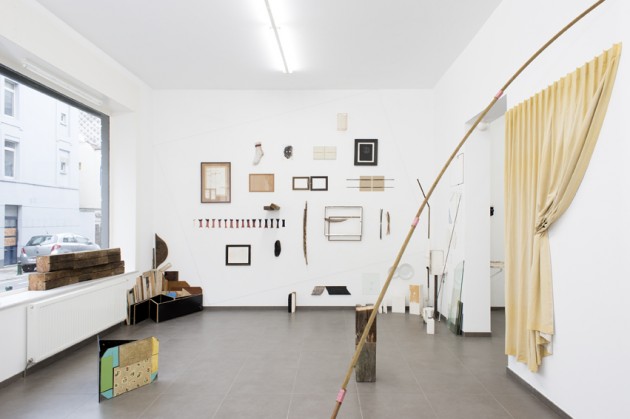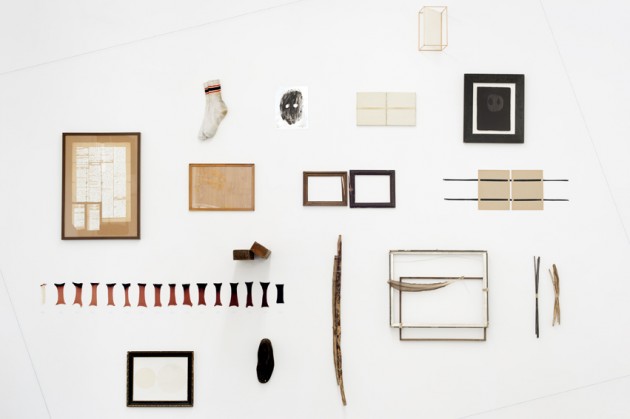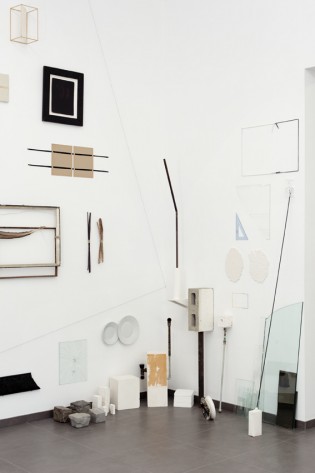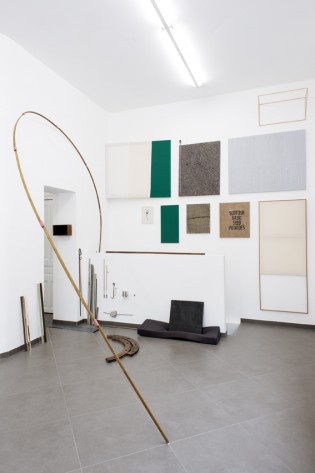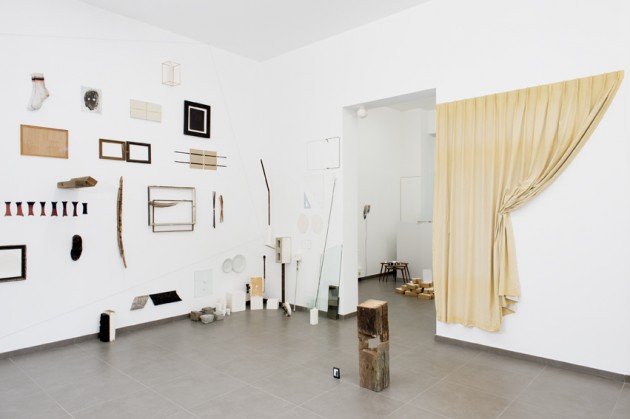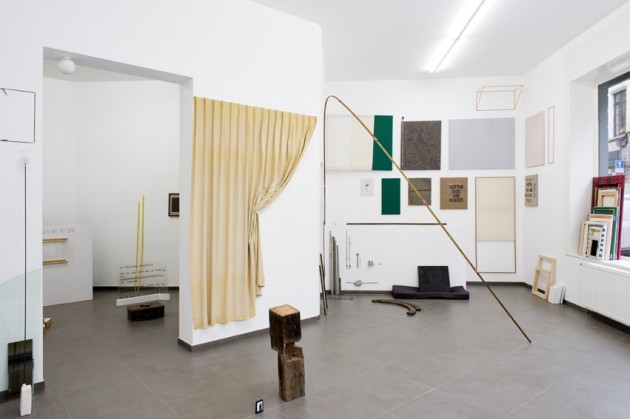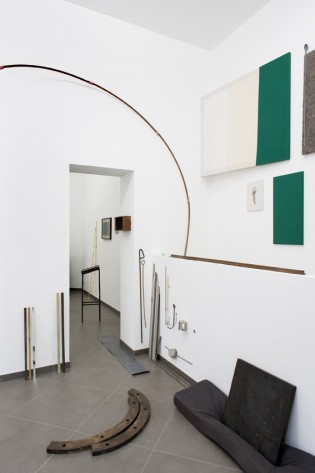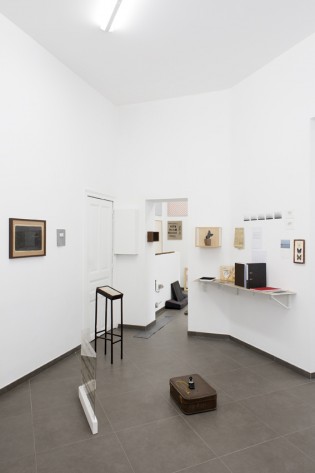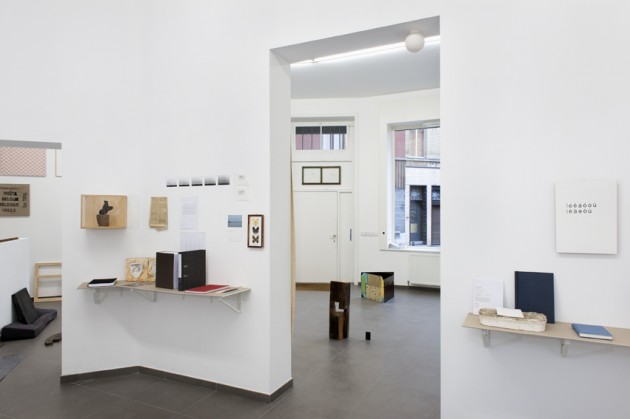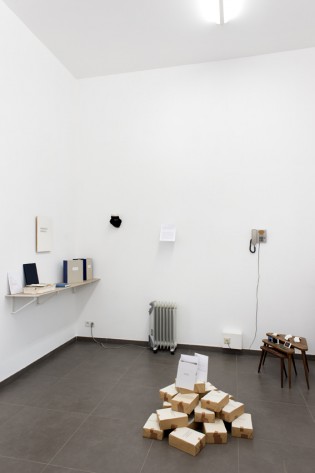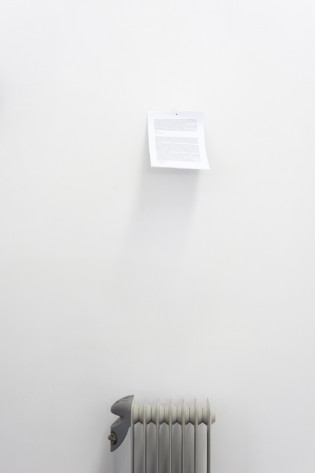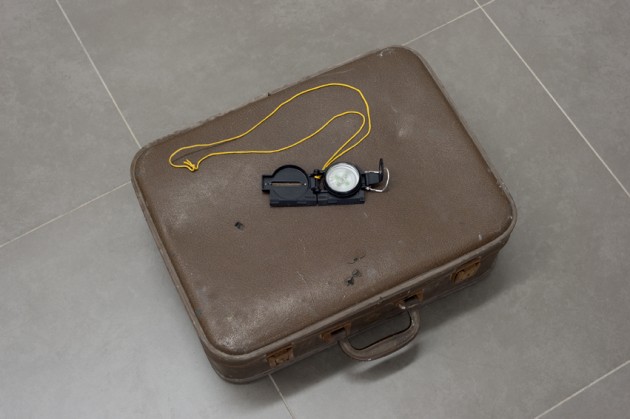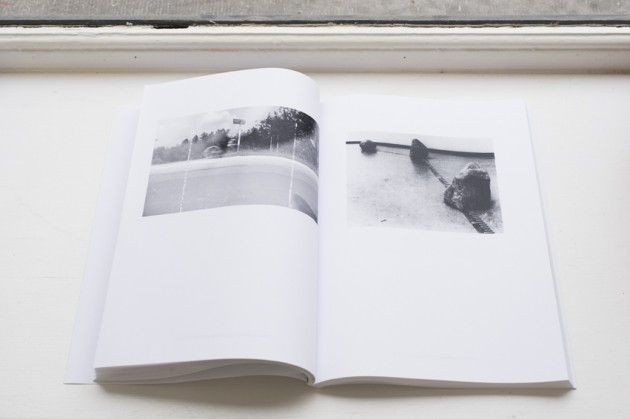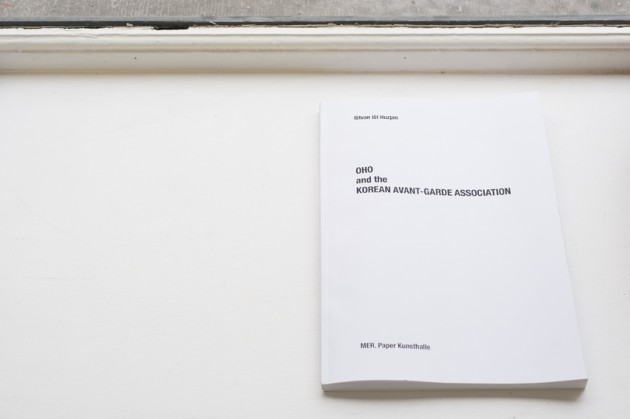IŠTVAN IŠT HUZJAN
NOVEMBER 6 - DECEMBER 21, 2013Press release
YOU and ME, WE and YOU
Opening event:
On the occasion of the artist’s solo exhibition opening the gallery is organizing a book launch
of Ištvan Išt
Huzjan’s latest publication OHO and the KOREAN AVANT-GARDE ASSOCIATION published by MER. Paper Kunsthalle. The
launch includes a performance OD TU DO TU by the artist and a conversation with Luc Derycke followed by an
evening of performative interventions in duets by Maeva Cunci & Dominique Gilliot, Géraldine Py & Roberto
Verde,
Bérénice Merlet & Armand Morin, Lea Drouet & Frederic Bernier, Amélie de Brouwer & Thibaut Espiau, Eléonore
Saintagnan & Grégoire Motte, Tina Javornik & Ištvan Išt Huzjan.
Ištvan Išt Huzjan
OD TU DO TU (FROM HERE TO HERE)
Huzjan’s performance is a simple gesture where the artist barefooted measures a distance between
two random architectural elements. To mark the starting point of the measuring the artist writes down OD TU
(from here)
directly on the first architectural element and to mark the end point the artist writes down the measured
distance on the second architectural element DO TU MERI x STOPAL (to here measures x number of feet).
Duets:
Maeva Cunci & Dominique Gilliot
WILLIAM FAULKNER NEVER WROTE ANY BOOK CALLED “JEFFERSON, MISSISSIPPI”
Prior to this performance, a list of items will be proposed by Dominique Gilliot to Maeva Cunci and vice
versa,
requesting that each of the listed objects shall be provided by the other part of the duet. Those objects will
be used as artifactual communicative tools triggering the fiction of the actual absence-presence of the two
performers. Those objects will act as transitional items destined to fill the gap left when one is away. Each
object will be associated with its description, uttered while the objects are presented, thus creating a kind
of staggering diagonal language.
Maeva Cunci lives in Brussels but will be in Sweden during the preparation of the performance. Dominique
Gilliot lives in Paris, but will be in Los Angeles during the preparation of this performance.
Géraldine Py & Roberto Verde
REMOTE ACTION #1
“Remote Action #1” is the first of a series of performances in case of absence.
The artist starts the action by phone call or sms.
“Remote Action #1” is a blackout order in the exhibition space.
Bérénice Merlet & Armand Morin
A STRING ATTACHED
Playing with two tin cans linked by a twine is a very simple game but there is something kind of
magical in
it for children. Can we make it even more magical? We decided to use this basic device more like a musical
instrument or at least for some non-verbal communication. So we’re going to play “Tin can telephone” in both
senses of the word with pinching the string, listening and amplifying the sounds it makes. Man will see
waves running along the twine between the two cans and slowly vanishing. An abstract and secret language
will emerge between us, as weird sounds will spread in the gallery’s basement.
Lea Drouet & Frederic Bernier
AUGMENTED HUMAN
It will be a kind of demonstration/exploration of the basic, physical, primary possibilities to be
associated to someone else with those exponential consequences: 2 is more than 1, and 2 is more than 2.
Amélie de Brouwer & Thibaut Espiau
INITIALES FIGURES
Contemporary ritual around a solitary trestle, A/T.
Eléonore Saintagnan & Grégoire Motte
ZUIGPLEK N°5
During the opening Eléonore gives a series of hickeys on Grégoire’s upper arm thus creating an
image
resembling a human skull.
Tina Javornik & Ištvan Išt Huzjan
POLJUB (A KISS)
The artists kiss each other repeatedly for an undefined period of time standing in the
passageway between
rooms of the gallery thus interrupting the movement of spectators.
Texte Art-Meme
OD TU DO TU
FR
Ištvan Išt Huzjan
En 1970, le groupe d’artistes slovènes OHO (1966-1971) fut invité à participer à l’exposition
Information
organisée par Kynaston McShine au MOMA de New-York. Les quatre membres du groupe – deux à New York, deux
autres à Ljubljana, « ont regardé simultanément le soleil et laissé tomber une allumette à 10 cm haut-dessus
d’une feuille de papier »[2], puis marqué sa position. L’oeuvre produite combinait l’ensemble des résultats
obtenus. Ce protocole visait à enregistrer la dimension tangible, bien que quasi imperceptible, des liens
qui unissaient les membres du groupe dans l’espace et dans le temps. Plus tard, David Nez, l’un des membres
du groupe, entrepris de documenter un voyage entre Ljubljana et Washington par le dessin. Il posa un crayon
sur une feuille de papier et enregistra les vibrations occasionnées par ce périple sur son corps.
Le travail d’Ištvan Išt Huzjan (né en 1981 à Ljubljana, en Slovénie) s’inscrit par maints aspects dans
cette lignée : il explore, expérimente et enregistre la persistance et la circulation de phénomènes, de
structures et de rencontres. Ištvan Išt Huzjan expose, en particulier, le caractère rémanent mais aussi
nomade de l’art conceptuel.
Pour parler de son travail, Ištvan Išt Huzjan montre non seulement ses propres œuvres, mais aussi des
cartes. L’artiste prépare et archive ses projets en traçant des lignes dans Google Maps. Son plus ancien
souvenir d’enfance : les chaussures de marche de son père.
En 2012, à l’occasion de la FIAC à Paris, Ištvan Išt Huzjan convia les visiteurs à une promenade en taxi au
cours de laquelle un acteur leur racontait « son » histoire, celle de Josko Hozjan, né en 1921 et décédé en
1997, arrivé en 1938 de Yougoslavie à la recherche d’une vie meilleure. Cette proposition ne relèvait pas
tant d’un reenactment – du fait de faire resurgir, dans le présent, un événement du passé – que du fait de
souligner, aujourd’hui, la persistance d’une histoire considérée peut-être trop hâtivement comme révolue, au
travers d’un déplacement non seulement temporel, mais aussi spatial. En effet, il s’agissait également de
révéler le caractère géographique de cette survivance, au travers de l’évocation du déplacement du migrant,
mais aussi d’un déplacement « touristique » des visiteurs de la FIAC dans les rues et les monuments
historiques de Paris.
Le caractère rémanent de l’histoire, sa capacité à émerger dans d’autres contextes, représente le cœur de
la pratique d’Ištvan Išt Huzjan. Cette rémanence de l’histoire collective se trouve, à chaque fois,
redoublée d’une histoire plus personnelle ou singulière. En 2012, l’artiste a exploré les oeuvres d’art de
la fin des années 1960 et du début des années 1970 dans les archives nationales de Séoul (Corée), en
s’appuyant sur le protocole suivant : ne choisir que des oeuvres qu’il avait la sensation d’avoir déjà vues
avant, ailleurs, dans les archives du groupe OHO conservées à la Moderna galerija de Ljubljana. Cette
recherche vient de donner naissance à un livre, OHO and The Korean Avant-Garde Association, qui révèle, via
la mémoire subjective de l’artiste, la persistance et la dissémination de formes artistiques a priori
étrangères les unes aux autres à une époque donnée.
La même année, Ištvan Išt Huzjan participe à un événement qui se propose de réactiver l’histoire de l’art
conceptuel européen et celle de ses déplacements au travers d’une exposition de groupe organisée en 1989
dans un train voyageant entre Paris et Zagreb, Simplon Express[3]. Il s’agissait, cette fois, d’effectuer le
voyage en sens inverse, de Zagreb vers Paris. La proposition d’Ištvan Išt Huzjan consista à documenter son
parcours dans la soute à bagages d’un autocar allant de Ljubljana à Venise, reprenant ainsi la place de ceux
qui, avant 2007, c’est-à-dire avant l’entrée de la Slovénie dans l’espace Schengen, se trouvaient contraints
de migrer ainsi[4]. De même, Migration of the european beech (2012) se fait l’écho métaphorique, via une
étude des processus de déplacement du hêtre depuis la Slovénie vers la Belgique pendant et après l’époque
glaciaire, de l’arrivée de nombreux travailleurs slovènes en Belgique dans les années 1920.
Ištvan Išt Huzjan nous rappelle que le nomadisme est aussi inséparable de la condition d’artiste : il se
présente lui-même comme « un jeune artiste se déplaçant en Europe à la recherche de possibilités pour créer
»[5], et se souvient que la richesse des collections d’art Renaissance des musées de Ljubljana s’explique en
grande partie par les déplacements des artistes entre les Flandres et l’Italie, via la Slovénie.
Ištvan Išt Huzjan s’intéresse aux processus de transition en tant que phénomènes historiques, mais aussi et
surtout à la manière dont ces phénomènes s’inscrivent sur le territoire et exercent une influence décisive
sur les déplacements. Comme l’écrit Edward W. Soja dans Seeking spatial justice : « les géographies dans
lesquelles nous vivons (…) ne sont pas qu’un arrière-plan inerte ni une scène neutre accueillant le théâtre
humain, elles sont envahies de forces matérielles et imaginaires qui affectent les événements et les
expériences, des forces qui peuvent nous nuire mais aussi nous soutenir dans presque tout ce que nous
entreprenons, individuellement et collectivement. »[6] Et puisque ces géographies impliquent aussi les
corps, il s’agit toujours de se rendre soi-même sur les lieux.
Revisiting the 1st meter square (2009-2011) prend pour point de départ une donnée subjective : un carré de
terre d’un mètre carré, de la dimension du bac à sable d’enfance de l’artiste – son « premier atelier »[7].
Ištvan Išt Huzjan a tracé sur la carte une ligne entre Amsterdam (où se trouvait alors son atelier) et
Ljubljana, puis cherché, tous les 100 kilomètres le long de cette ligne, une parcelle d’un mètre carré à
partager à titre temporaire avec son propriétaire. Un contrat fut signé pour chaque emplacement, dans le but
d’évaluer, dans chaque pays rencontré, le degré de confiance entre les signataires, d’après des critères à
la fois objectifs (les lois propres à chaque pays membre de l’espace Schengen) et subjectifs (la « valeur »
de la rencontre avec chaque propriétaire). On retrouve cette question de la valeur des échanges au travers
d’un déplacement géographique dans The Book of exchange : Ištvan Išt Huzjan a voyagé entre la Corée et la
Slovénie avec au départ dix euros en poche, qu’il a changé ensuite dans la monnaie nationale de chaque pays
traversé. Le fait de traverser physiquement ces frontières avait aboutit à une perte de 82,5% de la valeur
monétaire d’origine.
L’été dernier, à l’occasion de la Triennale d’art contemporain en Slovénie[8], Ištvan Išt Huzjan s’est
entouré d’artistes, curateurs et amis pour entreprendre une marche de plusieurs jours le long d’un ancien
chemin de treck reliant la Slovénie et la Croatie (E6-YU, 2013). Ce chemin autrefois célèbre avait cessé
d’exister dans les années 1990 après l’éclatement de la Yougoslavie et la subséquente création d’une
frontière entre les deux pays. A quelques jours de la réouverture de cette frontière du fait de l’entrée de
la Croatie dans l’espace Schengen, Ištvan Išt Huzjan a entrepris de réactiver collectivement ce périple,
afin d’en éprouver l’actualité.
Ištvan Išt Huzjan procède toujours par une mise en commun. Cette dimension se retrouve dans son travail que
l’on pourrait qualifier « d’atelier » – de peinture, de sculpture, ou d’installation. A l’heure où nous
écrivons, Ištvan Išt Huzjan envisage de présenter une partie de son travail d’atelier récent à l’occasion de
sa prochaine exposition à la galerie Sébastien Ricou à Bruxelles. L’exposition, intitulée You and Me, We and
You, explorera la question de la relation, et notamment de la relation amoureuse. Elle donnera lieu au
lancement de son livre OHO and The Korean Avant-Garde Association. Afin de procéder, une fois de plus, à une
mise en commun, Ištvan invitera aussi d’autres artistes – des artistes qui travaillent en couple ou en duos
– pour un programme de performances.
Dernièrement, Ištvan Išt Huzjan s’est associé à Bruxelles avec Thibaut Espiau et Grégoire Motte, non pas
pour produire un travail artistique en commun, mais parce qu’il souhaitait fonder un « groupe ». Ce groupe,
appelé Artists Club[9], invite régulièrement des artistes à exposer dans un coffre-fort subsistant dans
l’ancienne chambre forte d’un bijoutier. Une occasion, là encore, de tester la valeur des échanges dans un
espace géographique donné.
Cet article est paru sous une forme abrégée dans la revue :
L’Art même, n° 60, Bruxelles, 4e trim. 2013, p. 22.
Florance Cheval -
www.chevalflorence.wordpress.com
____________
[1] « OD TU DO TU » signifie en anglais « From Here to There ». C’est le titre d’une performance d’Ištvan Išt
Huzjan.
[2] Lucy R. Lippard, Six Years. The Dematerialization of the Art Object from 1966 to 1972, University of
California Press, 1973, p. 153.
Traduction de l’auteur.
[3] Au lendemain de la chute du Mur de Berlin, divers artistes comme Daniel Buren, Christian Boltanski, Alain
Fleischer, Goran Trbuljak, Sarkis, Bálint Szombathy, ont participé à ce projet.
[4] Entre 2001 et 2005, en tant qu’étudiant à l’Academia di bella arti de Venise, Ištvan Išt Huzjan avait
maintes fois effectué ce trajet en car entre les deux villes.
[5] Ištvan Išt Huzjan, artist statement.
[6] Edward W. Soja, Seeking spatial justice, University of Minnesota Press, 2010, p. 19. Traduction de
l’auteur.
[7] Rencontre avec l’artiste, Bruxelles, le 2 septembre 2013.
[8] Résilience, 7ème Triennale d’art contemporain en Slovénie, commissariat Nataša Petrešin-Bachelez, 20 juin
– 29 septembre 2013.
[9] Artists Club, rue du Houblon 63, 1000 Bruxelles, www.artistsclubcoffrefort.com
OD TU DO TU [1]
En
Ištvan Išt Huzjan
OHO and The Avant-Garde Korean Association
Editions Wed Paper Kunsthalle
www.merpaperkunsthalle.org/
Book launch on the occasion of the exhibition at Ricou Gallery
Ištvan Išt Huzjan, From Here, 2005
In 1970, the group of Slovenian artists OHO (1966-1971) was invited to participate in the exhibition
Information organized by Kynaston McShine at the MOMA in New York. The four members of the group – two in New
York, two in Ljubljana, “watched the sun and simultaneously dropped a match from 10 cm height above a sheet of
paper” [2] and marked its position. The finished work combined all the results of this exercise. This protocol
was designed to record the tangible dimension, although almost imperceptible, of the ties between the members
of the group in space and in time. Later, David Nez, one of the members of the group set out to document a
journey between Ljubljana and Washington by drawing. He put a pencil on a sheet of paper and recorded the
vibrations caused by the journey on his body.
The work of Ištvan Išt Huzjan (born in 1981 in Ljubljana, Slovenia) falls in many aspects within this line of
work: it explores, experiments and records the persistence and movement of phenomena, structures and meetings.
Ištvan Išt Huzjan exhibits, in particular, the residual but also nomadic character of conceptual art.
To talk about his work, Ištvan Išt Huzjan shows not only his own pieces, but also maps. The artist prepares
and archives his projects by drawing lines in Google Maps.
His earliest memory of childhood: the walking shoes of his father.
In 2012, during the FIAC in Paris, Ištvan Išt Huzjan invited visitors to ride in a taxi in which an actor told
them “his” story, that of Josko Hozjan, born in 1921 and dead in 1997, who arrived in Yugoslavia in 1938 in
search of a better life. This proposal does not constitute a reenactment – the act of making a past event
reappear in the present – so much as a highlight, today, of the persistence of a history that might be too
hastily considered as finished, through not only a temporal but also spatial displacement. Indeed, the
intention was also to reveal the geographical character of this survival, through the evocation of the
migrant’s movement, but also of a “tourist” trip for the visitors of the FIAC in the streets and among the
historical monuments of Paris.
The residual nature of history, its ability to emerge in other contexts, is the heart of the practice of
Ištvan Išt Huzjan. This persistence of the collective history is, each time, doubled by a more personal and
unique history. In 2012, the artist explored the art of the late 1960s and early 1970s in the National
Archives in Seoul (Korea), basing himself on the following protocol: select only works that he had the feeling
of having already seen before, in the archives of the OHO group stored at Moderna Galerija in Ljubljana. This
research has given birth to a book, OHO and The Avant-Garde Korean Association, which reveals through the
subjective memory of the artist the persistence and dissemination of artistic forms, a priori strangers to one
another at a given time.
The same year, Ištvan Išt Huzjan participated in an event that aims to revive the history of European
conceptual art and that of its travels through a group exhibition in 1989 in a train traveling between Paris
and Zagreb, Simplon Express [3]. This time it was about taking the trip in the opposite direction, from Zagreb
to Paris. The proposal of Ištvan Išt Huzjan consisted of documenting his trip in the luggage hold of a bus
travelling from Ljubljana to Venice, thus taking the place of those who, before 2007, that is before the entry
of Slovenia into the Schengen area, were forced to migrate this way [4]. Similarly, Migration of the European
Beech (2012) echoes in a metaphorical way, via a study of the moving process of beech trees from Slovenia to
Belgium during and after the Ice Age, the arrival of many Slovenian workers to Belgium in the 1920s.
Ištvan Išt Huzjan reminds us that nomadism is also inseparable from the condition of the artist: he presents
himself as “a young artist traveling in Europe in search of ways to create,” [5] and remembers that the rich
collections of Renaissance art museums in Ljubljana is explained largely by the movement of artists between
Flanders and Italy through Slovenia.
Ištvan Išt Huzjan focuses on the transition process as a historical phenomenon, but also and especially on how
these phenomena become part of the territory and have a decisive influence on movement. As written by Edward
W. Soja in Seeking Spatial Justice “the geographies in which we live (…) are not only an inert background or a
neutral scene welcoming the human theater, they are invaded by material and imaginary forces that affect
events and experiences, forces that can harm us but also support us in almost everything we do, individually
and collectively.” [6] And since these geographies also involve the body, it is always about getting yourself
to that spot.
Revisiting the 1st Square Meter (2009-2011) takes as its starting point a subjective data: a square of land
measuring one square meter, the size of the artist’s childhood sandbox – his “first workshop” [7]. Ištvan Išt
Huzjan drew a line on the map between Amsterdam (where his studio was situated at the time) and Ljubljana, and
sought every 100 kilometers along this line a plot of one square meter to share with the owner on a temporary
basis. A contract was signed for each location in order to evaluate, for each country visited, the degree of
trust between the signatories, based on criteria that are both objective (the laws of each member country of
the Schengen area) and subjective (the “value” of the encounter with each owner).
We find this issue of the value of exchange again through a geographical shift in The Book of Exchange: Ištvan
Išt Huzjan traveled between Korea and Slovenia starting with ten euros in his pocket, which he then changed
into the national currency of each country through which he traveled. Physically crossing these borders
resulted in the loss of 82.5% of the original monetary value.
Last summer, on the occasion of the Triennial of Contemporary Art in Slovenia [8], Ištvan Išt Huzjan
surrounded himself with artists, curators and friends to take a walk of several days along an ancient road
connecting Slovenia and Croatia (E6 – YU, 2013). This once famous road had ceased to exist in 1990 after the
breakup of Yugoslavia and the subsequent creation of a border between the two countries. A few days before the
reopening of the border due to the entry of Croatia into the Schengen area, Ištvan Išt Huzjan set out to
revive collectively this route, in order to experience its current relevance.
Ištvan Išt Huzjan always proceeds through synergy. This dimension is reflected in the part of his work that
could be qualified as “studio work” – paintings, sculptures, or installations. At the time of writing, Ištvan
Išt Huzjan plans to present a part of his work on the occasion of his next solo exhibition at Ricou Gallery in
Brussels. The exhibition, entitled You and Me, We and You will explore the question of relationship, and
especially the love relationship. It will include the launch of his book OHO and The Avant-Garde Korean
Association. To proceed, once again, through synergy, Ištvan also invites other artists – artists who work in
pairs or in groups – for a performance program.
Recently, Ištvan Išt Huzjan created an association together with Thibaut Espiau and Gregoire Motte in
Brussels, not to produce artistic work together, but because he wanted to establish a “group.” This group,
called Artists Club [9] regularly invites artists to exhibit in a safe remaining in the former vault of a
jeweler. An opportunity, once again, to test the value of exchanges in a given geographical space.
Florence Cheval
[1] “OD TU DO TU” means in English “From Here to There.” This is the title of a performance by Ištvan Išt
Huzjan.
[2] Lucy R. Lippard, Six Years. The Dematerialization of the Art Object from 1966 to 1972, University of
California Press, 1973, p. 153.
Translation by the author.
[3] The day after the fall of the Berlin Wall, various artists such as Daniel Buren, Christian Boltanski,
Alain Fleischer, Goran Trbuljak, Sarkis, Bálint Szombathy participated in this project.
[4] Between 2001 and 2005, as a student at the Academia di Bella Arti in Venice, Ištvan Išt Huzjan had
repeatedly made the bus trip between the two cities.
[5] Ištvan Išt Huzjan, artist statement.
[6] Edward W. Soy Seeking spatial justice, University of Minnesota Press, 2010, p. 19. Translation by the
author.
[7] Meeting with the artist, Brussels, 2 September 2013.
[8] Résilience, 7th Triennial of Contemporary Art in Slovenia, curated by Nataša police Petrešin – Bachelez
June 20 to September 29, 2013.
[9] Artists Club, 63 rue du Houblon, 1000 Brussels, www.artistsclubcoffrefort.com
Video
Press review
- Review: art
Views
